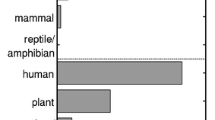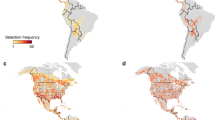Abstract
The migration of Neotropical birds may provide a robust measure of changing environmental condition along the migratory route. I review previous work on assessing broad-scale stopover quality in the eastern United States and discuss how future research can aid regional environmental assessment. Scientists can quantify how environmental changes affect the migratory system, and then monitor for those effects on migrant abundance from year to year. The cyclical nature of migration provides a constant re-evaluation of habitat quality and spatial distribution by migrant birds. Avian monitoring programs can detect changes in migrant abundance. Migrating birds may thus provide a living sensor of environmental change, enabling broad-scale environmental assessments to detect and address habitat degradation early on, allowing local managers to prioritize restoration efforts accordingly. Understanding the environmental factors driving stopover selection, and how birds move between stopovers during migration, is an important first step.
Similar content being viewed by others
References
Alerstam, T. and Hedenstrom, A.: 1998, 'The development of bird migration theory', J. Avian Biol. 29, 343-369.
Askins, R.A., Lynch, J.F. and Greenberg, R.: 1990, 'Population declines in migratory birds in eastern North America', Current Ornithology. 7, 1-57.
Berthold, P.: 1988. 'The control of migration in European warblers', Acta XIX Congressus Internationalis Ornithologici. 19, 215-249.
Berthold, P.: 1990, 'Genetics of migration', in E. Gwinner (ed.), Bird Migration: The Physiology and Ecophysiology, Springer, Berlin, Germany, p. 429.
Berthold, P.: 1991, Orientation in Birds, Birkhauser, Boston, MA, USA, p. 331.
Berthold, P., Helbig, A.J., Mohr, G. and Querner, U.: 1992, 'Rapid microevolution of migratory behavior in a wild bird species', Nature. 360, 668-669.
Bradley, M.P. and Smith, E.R.: 2004, 'Using Science to Assess Environmental Vulnerabilities', Environ. Mont. Assess. 94, 1-7.
Brawn, J.D. and Robinson, S.K.: 1996, 'Source-sink population dynamics may complicate the interpretation of long-term census data,' Ecology. 77 (1), 3-12.
Burke, D.M. and Nol, E.: 1998, 'Influence of food abundance, nest-site habitat, and forest fragmentation on breeding ovenbirds,' Auk. 115 (1), 96-104.
Cox, G.W.: 1985, 'The evolution of avian migration systems between temperate and tropical regions of the new world,' Am. Nat. 126, 451-474.
Crooks K.R. and Soule M.E.: 1999, 'Mesopredator release and avifaunal extinctions in a fragmented system', Nature. 400, 563-566.
DeSante, D.F.: 1973, 'Analysis of the fall occurrences and nocturnal orientations of vagrant warblers (Parulidae) in California', Ph.D. dissertation, Stanford University, Stanford, CA, USA.
Flather, C.H. and Sauer J.R.: 1996, 'Using Landscape Ecology to test hypotheses about largescale abundance patterns in migratory birds', Ecology. 77 (1), 28-35.
Furness, R.W. and Greenwood, J.J.D. (eds).: 1993, Birds as Monitors of Environmental Change Chapman and Hall, London, UK, p. 356.
Holmes, R.T. and Sherry, T.W.: 1988, 'Assessing population trends of New Hampshire forest birds: Local vs. regional patterns', Auk. 105, 756-768.
Hutto, R.L.: 1985, 'Habitat selection by nonbreeding, migratory land birds', in M. Cody (ed.), Habitat Selection in Birds, Academic Press, New York, NY, USA, p. 558.
Hutto, R.L.: 2000, 'On the importance of en route periods to the conservation of migratory landbirds', Studies in Avian Biology. 20, 109-114.
Johnson, D.H.: 1980, 'The comparison of usage and availability measurements for evaluating resource preference', Ecology. 61, 65-71.
Keast, A. and Morton, E.S. (eds.).: 1980, Migrant Birds in the Neotropics: Ecology, Behavior, Distribution, and Conservation Smithsonian Institution Press, Washington, DC, USA, p. 576.
Kerlinger, P.: 1995, How Birds Migrate Stackpole Books, Mechanicsburg, PA, USA, p. 228.
Kokko, H.: 1999, 'Competition for early arrival in migratory birds', J. Anim. Ecol. 68, 940-950.
Levey, D.J. and Stiles, F.G.: 1992, 'Evolutionary precursors of long-distance migration: Resource availability and movement patterns in Neotropical landbirds', American Naturalist. 140, 447-476.
Machtans, C.S., Villard, M.A. and Hannon, S.J.: 1996, 'Use of riparian buffer strips as movement corridors by forest birds', Conserv. Biol. 10 (5), 1366-1379.
Martin, G.R.: 1990, 'The visual problems of nocturnal migration', in E. Gwinner (ed.), Bird Migration: The Physiology and Ecophysiology, Springer, Berlin, Germany, p.429.
Monkkonen, M., Helle, P. and Welsh, D.: 1992, 'Perspectives on Palearctic and Nearctic bird migration: Comparisons and overview of life-history and ecology of migrant passerines', Ibis. 134 suppl., 7-13.
Moore, F.R., and Aborn, D.A.: 1996, 'Time of departure by summer tanagers (Piranga rubra) from a stopover site following spring trans-Gulf migration', Auk. 113 (4), 949-952.
Moore, F.R. and Aborn, D.A.: 2000, 'Mechanisms of en route habitat selection: How do migrants make habitat decisions during stopover?', Studies in Avian Biology. 20, 34-42.
Moore, F.R., Gauthreaux, S.A. Jr, Kerlinger, P. and Simons, T.R.: 1993, 'Stopover habitat: Management implications and guidelines', in Finch and Stangel, (eds.), Status and Management of Neotropical Migratory Birds, General Technical Report RM-22 9. U.S. Forest Service, Fort Collins, CO, USA, p. 422.
Moore, F.R., and Simons, T.R.: 1992, 'Habitat suitability and stopover ecology of Neotropical landbird migrants', in J.M. Hagan, III and D.W. Johnston (eds.), Ecology and Conservation of Neotropical Migrant Landbirds, Smithsonian Press, Washington, DC, USA.
Morse, D.H.: 1989, American Warblers, Harvard Univsity Press, Cambridge, MA, USA, p. 406.
Nur, N., Jones, S.L. and Geupel, G.R.: 1999, 'A Statistical Guide to Data Analysis of Avian Monitoring Programs,' BTP-R6001-1999 U.S. Department of the Interior, Fish and Wildlife Service, Washington, DC, USA, p. 54.
Pennycuick, C.J.: 1997, 'Actual and optimum flight speeds: Field data reassessed', J. Exp. Biol. 200, 2355-2361.
Petit, D.R.: 2000, 'Habitat use by landbirds along Nearctic-Neotropical migration routes: Implications for conservation of stopover habitats', Studies in Avian Biology. 20, 15-33.
Rappole, J.H., Morton, E.S., Lovejoy, T.E. and Ruos, J.L.: 1995, Nearctic avian migrants in the Neotropics R.R. Donnelley and Sons, New York, NY, USA, p. 324.
Robbins, C.S., Droege, S. and Sauer, J.R.: 1989, 'Monitoring bird populations with Breeding Bird Survey and atlas data', Ann. Zool. Fennici. 26, 297-304.
Robinson, S.K., and Wilcove, D.S.: 1994, 'Forest fragmentation in the temperate zone and its effects on migratory songbirds', Bird Conserv. Int. 4, 233-249.
Simons, T.R., Pearson, S.M. and Moore, F.R.: 2000, 'Application of spatial models to the stopover ecology of Trans-Gulf migrants', Studies in Avian Biology. 20, 15-33.
Tankersley, R. Jr.: 2002, 'Geography of Stopover Habitats and Migratory Pathways for Neotropical Migratory Forest Birds in the Eastern United States', PhD. Dissertation University of Tennessee, Knoxville, TN, USA, p. 59.
Tankersley, Jr., R. and Orvis, K.: “Modeling the geography of migratory pathways and stopover habitats for neotropical migratory birds.” Online Journal of Conservation Ecology, (2003). 10 May 2003. <http://www.consecol.org/vol7/iss1/art7>
Van Horne, B.: 1983, 'Density as a misleading indicator of habitat quality', J. Wildl. Manage. 47, 893-901.
Winker, K., Warner, D.W. and Weisbrod, A.R.: 1991, 'Unprecedented stopover site fidelity in a Tennessee Warbler', Wilson Bull. 103, 514-516.
Winker, K., D.W. Warner, and A.R. Weisbrod.: 1992, 'Daily mass gains among woodland migrants at an inland stopover site', Auk. 109(4): 853-862.
Woodrey, M.S.: 2000, 'Age-dependent aspects of stopover biology of passerine migrants', Studies in Avian Biology. 20: 43-52.
Rights and permissions
About this article
Cite this article
Tankersley, R.D. Migration of Birds as an Indicator of Broad-Scale Environmental Condition. Environ Monit Assess 94, 55–67 (2004). https://doi.org/10.1023/B:EMAS.0000016879.82499.b6
Issue Date:
DOI: https://doi.org/10.1023/B:EMAS.0000016879.82499.b6




